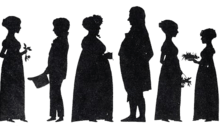Knud Ibsen

Knud Plesner Ibsen (3 October 1797, in Skien – 24 October 1877, in Skien) was the father of playwright Henrik Ibsen, and is widely considered the model for many central characters in his son's plays, including most famously Jon Gynt in Peer Gynt[1] and Old Ekdahl in The Wild Duck, but also Daniel Hejre in The League of Youth.[2][3][4]
Once a rich merchant in Skien with a lavish lifestyle, Knud Ibsen went bankrupt, an experience which made him an embittered and moody man, and which profoundly influenced his son's work. Knud Ibsen had, like the character Old Ekdahl, also been a lieutenant and a huntsman in his youth.[5][6][7][8]
Knud Ibsen was the son of ship's captain Henrich Ibsen and Johanne Plesner; his paternal great-grandfather had immigrated from Denmark to Norway in 1726; the family's earliest known ancestor was Rasmus Ibsen (1632–1703) from Stege, Denmark (cf. Rasmus Gynt in Peer Gynt). His father died at sea in 1797, and the following year, Johanne married Ole Paus, a ship-owner, and he grew up on the Paus family estate Rising. He was the elder half-brother of lawyer and member of parliament Christian Cornelius Paus and ship-owner and banker Christopher Blom Paus.
Ibsen married Marichen Cornelia Martine Altenburg, daughter of wealthy merchant Johan Andreas Altenburg and Hedvig Paus (the sister of his step-father); they had known each other since childhood.[9]
Young Henrik left Skien never to return at 15, in 1844. He never saw his parents again after his breakthrough as a world-famous playwright, living mostly abroad for 27 years. Knud Ibsen was conscious and proud of his son's success, commenting that "when the Pauses are dead, they are dead, but my name will live on."[10]
References
- ↑ Survey of Articles on Ibsen: 2007, 2008 (PDF). The Ibsen Society of America. 2009. p. 40. Retrieved 2011-06-22.
- ↑ Oskar Mosfjeld, Henrik Ibsen og Skien: en biografisk og litteratur-psykologisk studie, Gyldendal, 1949
- ↑ Edda: nordisk tidsskrift for litteraturforskning, Vol. 56, 1956 ["I gamle Ekdals skikkelse ser dikteren på sin far, den forkomne Knud Ibsen, med et forsonende og medfølende blikk"]
- ↑ Halvdan Koht, Henrik Ibsen: 1867-1906, Aschehoug, 1954
- ↑ Lawrence Grolnick, "Ibsen's Truth, Family Secrets, and Family Therapy", Family Process, Volume 22, Issue 3, pp. 275–288, September 1983
- ↑ Bodil Nævdal, Bak en gyllen fasade: Sigurd Ibsens brev til familien 1883-1929, Aschehoug, 1997
- ↑ William Amos, The originals: who's really who in fiction, Cape, 1985
- ↑ Hans Levander, Tur och retur 1800-talet: litterär orientering, Liber Förlag, 1979 ["Den sista inkarnationen av Knud Ibsen i Henrik Ibsens diktning är gamle löjtnant Ekdal i "Vildanden". Den visar att Ibsen omsider, efter faderns död, försonat sig med hans minne."]
- ↑ Høgvoll, Arvid; Bærland, Ruth (1996). Henrik Ibsen: herregårder, kammerherrer, godseiere og proprietærer : brokker av en slektshistorie.
- ↑ Schneider, J. A. (1924). "Henrik Ibsens slegt". Fra det gamle Skien (in Norwegian). 3. Skien: Erik St. Nilssens Forlag. Archived from the original on 2011-06-22. Retrieved 2011-06-22.
Naar Paus'ene er daue, saa er de daue, men mit navn vil leve, det
